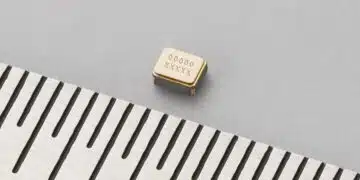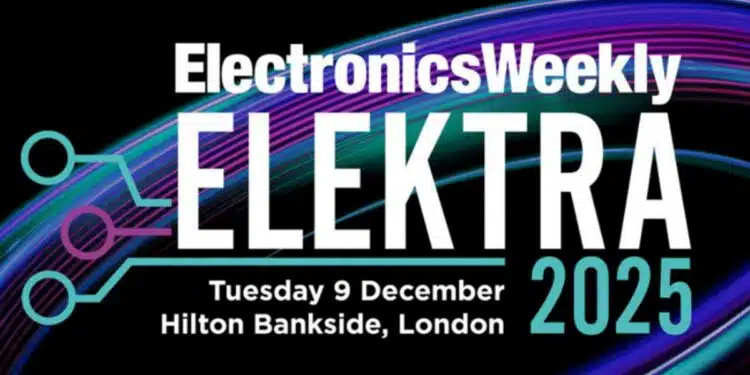Electronics Weekly is very proud to reveal the finalists for the prestigious electronics industry event Elektra Awards 2025.
The exceptional companies and individuals have demonstrated unparalleled excellence, dedication, and innovation in their field, not only embracing the challenges posed by the industry but rising above and pushing the boundaries to set new standards.
You can view the full list of finalists across the Elektra categories on the dedicated Elektra website and they are also listed below.
Congratulations to all the companies and individuals that have been selected and recognised for their achievements!
Nomination in the category of:
Passive/Interconnection/Electromechanical Product of the Year
Molex, HSAutoLink C
Panasonic Industry Europe, ZVU series conductive polymer hybrid aluminium electrolytic capacitors
Pickering Electronics, Series 125 ultra-high density 5mm² reed relays
Same Sky, AMT25 absolute encoder series
Saras Micro Devices, STILE module
Smiths Interconnect, Cat5e and Cat6A high-speed data transmission modules
Smiths Interconnect, Mini-Lock connector
Vishay Intertechnology, SGTPL-28 Series space-grade planar transformers
Molex HSAutoLink C Interconnect System
The HSAutoLink C Interconnect System is ideal for automotive applications requiring compact, reliable, and high-performance data and power connectivity, all within a miniaturized, robust form factor. The HSAutoLink C System is a USCAR Type C interface, designed to deliver combined-system data rates up to 40Gbps and up to 240W of power. The system meets USB 3.2 Gen 2×2 and DisplayPort specifications, offers sealed and unsealed versions, and is designed to support LVDS and Ethernet.
Panasonic Industry Europe, ZVU series conductive polymer hybrid aluminium electrolytic capacitors
Panasonic Industry Europe announces the launch of its new ZVU Series Hybrid aluminum capacitors with high ripple current in compact case sizes. Designed to meet the demands of advanced electronic systems, the ZVU Series epitomizes exceptional reliability, extended lifespan, and superior thermal management. The ZVU Series Conductive Polymer Hybrid Aluminum Electrolytic Capacitors distinguish themselves with an impressive ripple current range of 3.3Arms to 4.6Arms—up to double that of comparable case sizes from competitors. Coupled with a reduced Equivalent Series Resistance(ESR) as low as 12mΩ, these capacitors integrate the best of electrolytic and solid polymer technologies. This synergy ensures unmatched efficiency and stability, even under extreme thermal conditions reaching up to 135°C.
Pickering Electronics, Series 125 ultra-high density 5mm² reed relays
Pickering Electronics has introduced its latest high-density reed relay, Series 125 – the industry’s smallest two pole DPST (dual-pole, single-throw) reed relay – switching up to an impressive 1 Amp, 20 Watts, while stacking on a compact 5mm x 5mm pitch. This high packing density maximises PCB real estate, making the relays ideal for very high-density applications such as ATE (automated test equipment) switching matrices or multiplexers. The relay also excels in mixed-signal environments, offering high insulation resistance (>1012 Ω) and low contact resistance, thanks to its sputtered ruthenium instrumentation-grade switches.
Same Sky, AMT25 absolute encoder series
Same Sky’s Motion and Control Group announced the addition of a new series to its innovative AMT absolute encoder family designed to support larger motor shaft sizes from 9 mm to 15.875 mm (5/8 inch). The AMT25 series, based on Same Sky’s proprietary capacitive ASIC technology, brings the same high levels of durability, accuracy, and immunity to environmental particulates as current AMT encoder models. Outputting 12 bits or 14 bits of absolute position information with single-turn or multi-turn output options, the AMT25 utilizes full duplex Serial Peripheral Interface (SPI) communication for high accuracy position data. Offering radial or axial cable connections, this absolute encoder series is housed in a compact modular package with a locking hub for ease of installation. It boasts low power consumption of 16 mA at 5 V, a wide operating temperature range from -40 to 105°C, and high accuracy of ±0.2 mechanical degrees. The digital nature of the AMT25 series also allows users to set the zero position via Same Sky’s AMT Viewpoint™ GUI or the encoder’s SPI protocol (single-turn versions only).
Saras Micro Devices, STILE module
Saras Micro Devices announced its STILE technology to enhance device package integration for AI and HPC applications. The company’s technology, which enables in-package power delivery, aligns with the goals of the projects and supports the development of advanced packaging solutions. These collaborations aim to advance U.S. semiconductor manufacturing capabilities and maintain leadership in the field.
Smiths Interconnect, Cat5e and Cat6A high-speed data transmission modules
Smiths Interconnect announced the addition of two new data transmission modules to its modular and minimodular connector ranges. The Cat5e and Cat6A modules, designed for industrial, military, and aerospace applications, offer high performance, durability, and reliability in harsh environments. These modules feature hyperboloid contact technology, high-quality insulator materials, and snap-in contacts for easy assembly.
Smiths Interconnect, Mini-Lock connector
Smiths Interconnect introduced the Mini-Lock Connector, a new product enabling extremely high-frequency operation at up to 110 GHz. This connector, designed for mission-critical applications like satellites and military use, features a robust locking mechanism for reliable data transfer in extreme environments.
Vishay Intertechnology, SGTPL-28 Series space-grade planar transformers
Vishay Intertechnology, Inc. introduced a new series of low profile, space-grade planar transformers for power conversion applications. These transformers offer a smaller size, higher density, and customizable options compared to traditional planar transformers, meeting MIL-STD-981 class S requirements. They are suitable for use in switch mode power supplies and DC/DC and AC/DC converters.





























